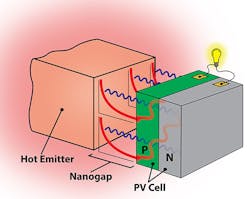Heat is an inevitable byproduct of almost any electronic circuit operating at a reasonable power level. Some of that heat is salvaged as usable energy, however., and the U.S. Army Research Laboratory (ARL) is funding research at the University of Michigan to develop a new approach to more effectively convert heat into electricity. This approach can be used with photovoltaic (PV) cells to provide sources of energy in addition to power from the emitter to the PV cell.
The research, which is referred to as thermophotovoltaics (TPV), is useful to soldiers in the field since it can expand on the sources of power for electronic devices. The approach also allows devices to work with sunlight for power during the day and any combustible fuel for power during the night for flexibility in providing power to different electronic systems. The new power generation technique provides an effective means of remote power generation and efficient waste heat recovery. In a traditional PV cell, photons from sunlight are converted to electrical energy. In contrast, with a TPV device, light from a hot object heated by any source can be converted directly into electricity.
The ARL is funding research at the University of Michigan to develop a new approach to more effectively convert heat into electricity.
The results of the work, recently published by graduate students and professors from the mechanical engineering department of the University of Michigan, explores how a hot object can be used as a PV emitter. One of the professors, Edgar Meyhofer, had this to offer: “Our work clearly demonstrates that performance of thermophotovoltaic devices that employ a photovoltaic cell and a hot object as an emitter, can be dramatically enhanced.” With heat as the energy source, the structure of TPV emitters and PV cells can be optimized to reach efficiencies rivaling those of current PV technologies.
“Unlike traditional photovoltaic technologies, thermophotovoltaic devices do not rely on sunlight for generating power,” explained Dr. Anthony Florino, a postdoctoral fellow at the University of Michigan and lead author of the research article on the technique. “They can use any source of heat. This makes them particularly well-suited for generating power at night or even indoors, and they can even be made portable for generation in remote locations.”
The TPV work was funded by the Army Research Office (and its parent office, the ARL), the U.S. Department of Energy Basic Energy Sciences, and the National Science Foundation (NSF).
About the Author
Jack Browne
Technical Contributor
Jack Browne, Technical Contributor, has worked in technical publishing for over 30 years. He managed the content and production of three technical journals while at the American Institute of Physics, including Medical Physics and the Journal of Vacuum Science & Technology. He has been a Publisher and Editor for Penton Media, started the firm’s Wireless Symposium & Exhibition trade show in 1993, and currently serves as Technical Contributor for that company's Microwaves & RF magazine. Browne, who holds a BS in Mathematics from City College of New York and BA degrees in English and Philosophy from Fordham University, is a member of the IEEE.


